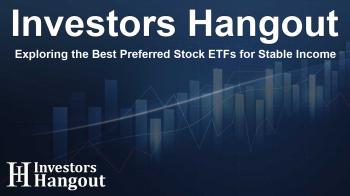Exploring the Best Preferred Stock ETFs for Stable Income

Understanding Preferred Stock ETFs
As we step into a new year, many investors find themselves navigating a landscape filled with uncertainties. The market's recent performance, while strong, leaves a cloud of unpredictability hanging over future investments. Investors are increasingly seeking safer avenues, and one strategy worth considering is investing in preferred stock ETFs. These funds can offer a protective buffer against volatility, combining features of both stocks and bonds.
Preferred stocks often fly under the radar but can deliver enhanced returns compared to traditional bonds, thanks to their unique structure. Unlike common shares, which depend heavily on market appreciation, preferred stocks deliver fixed payments, making them a favorable option for those wanting more stability. They also come with prioritized dividend payments, making them a reliable choice for income-focused investors.
Preferred stock ETFs further diversify risk by investing across a range of preferred stocks and improving liquidity compared to individual bonds, creating a suitable option for cautious investors aiming for consistent returns.
1. iShares Preferred and Income Securities ETF: Leading the Charge
The iShares Preferred and Income Securities ETF (NASDAQ: PFF) stands out as a market leader among preferred stock ETFs, boasting an impressive asset base of $14.7 billion. This fund capitalizes primarily on investments in the financial sector, utilizing over 450 different companies in its portfolio to offer significant diversification. The average trading volume is considerably high compared to its peers, making it an attractive choice for investors.
With an annual dividend yield of 6.3% and an expense ratio of just 0.46%, PFF presents a solid option for those seeking both stability and returns. However, investors should be aware that its strong focus on financials can impact overall portfolio balance, necessitating careful portfolio management.
2. First Trust Preferred Securities and Income ETF: A Unique Approach
Another noteworthy option is the First Trust Preferred Securities and Income ETF (NYSE: FPE), which distinguishes itself by incorporating not only preferred shares but also other income-producing securities such as corporate bonds and convertible securities. An actively managed fund, it does come with a premium price tag and a higher expense ratio at 0.85%.
FPE’s concentration on the financial sector complements its investments in various industries, including utilities and energy. This fund aims for total returns along with dividend income, having returned approximately 11% in the past year. This performance surpasses that of PFF while offering investors an annual dividend yield of 5.67%, creating a dual-benefit scenario for prudent investors.
3. Invesco Preferred ETF: Focusing on Quality
The Invesco Preferred ETF (NYSE: PGX) takes a distinctive approach by utilizing an index of U.S.-issued, fixed-rate preferred securities. It targets securities rated at least B3 and manages to encompass about 525 holdings, representing roughly 80 different companies. This diversification strategy allows PGX to maintain a competitive edge in the trading market.
PGX boasts a 5.86% annual dividend yield and a low expense ratio of 0.50%. It is notable for its exceptional trading volume, a characteristic that appeals to active traders seeking liquidity in their investments. Investors looking for dynamic engagement with their preferred stock investments will find PGX a compelling choice.
The Value of Preferred Stocks in an Investment Portfolio
Preferred shares may not be top-of-mind for many investors, but their unique qualities render them a vital component of a well-rounded investment strategy. They blend the stability of fixed-income securities with the growth potential of equities, providing the benefits of both worlds. As awareness of these benefits grows, dedicated ETFs that focus on preferred stocks are becoming an efficient way to integrate these assets into broader portfolios.
Frequently Asked Questions
1. What are preferred stock ETFs?
Preferred stock ETFs invest in preferred stocks which combine features of stocks and bonds, providing fixed dividends and enhanced stability.
2. Why should I consider investing in preferred stock ETFs?
They offer a defensive investment strategy, providing more stability and income than traditional stocks, making them ideal during uncertain market conditions.
3. How do iShares Preferred and Income Securities ETF and First Trust Preferred Securities ETF compare?
PFF focuses predominantly on financial institutions for higher diversification, while FPE also incorporates corporate bonds and aims for total returns.
4. What is the expense ratio of these ETFs?
The iShares ETF has an expense ratio of 0.46%, First Trust has 0.85%, and Invesco Preferred ETF's ratio is 0.50%.
5. What kind of returns can I expect from these preferred stock ETFs?
Potential returns vary; for example, PFF yields around 6.3% annually, while First Trust and Invesco offer returns of approximately 5.67% and 5.86%, respectively.
About Investors Hangout
Investors Hangout is a leading online stock forum for financial discussion and learning, offering a wide range of free tools and resources. It draws in traders of all levels, who exchange market knowledge, investigate trading tactics, and keep an eye on industry developments in real time. Featuring financial articles, stock message boards, quotes, charts, company profiles, and live news updates. Through cooperative learning and a wealth of informational resources, it helps users from novices creating their first portfolios to experts honing their techniques. Join Investors Hangout today: https://investorshangout.com/
Disclaimer: The content of this article is solely for general informational purposes only; it does not represent legal, financial, or investment advice. Investors Hangout does not offer financial advice; the author is not a licensed financial advisor. Consult a qualified advisor before making any financial or investment decisions based on this article. The author's interpretation of publicly available data shapes the opinions presented here; as a result, they should not be taken as advice to purchase, sell, or hold any securities mentioned or any other investments. The author does not guarantee the accuracy, completeness, or timeliness of any material, providing it "as is." Information and market conditions may change; past performance is not indicative of future outcomes. If any of the material offered here is inaccurate, please contact us for corrections.
